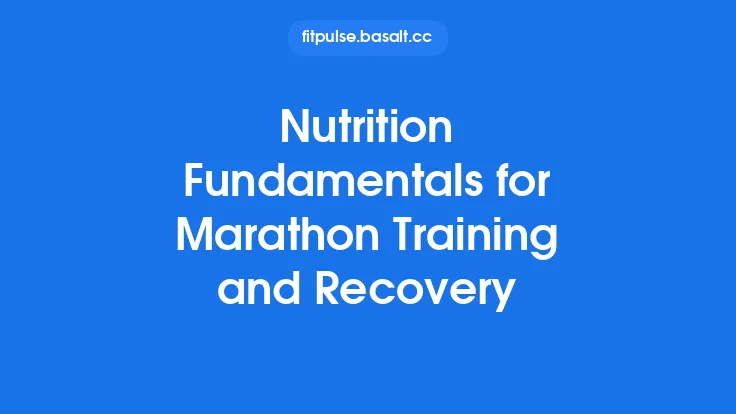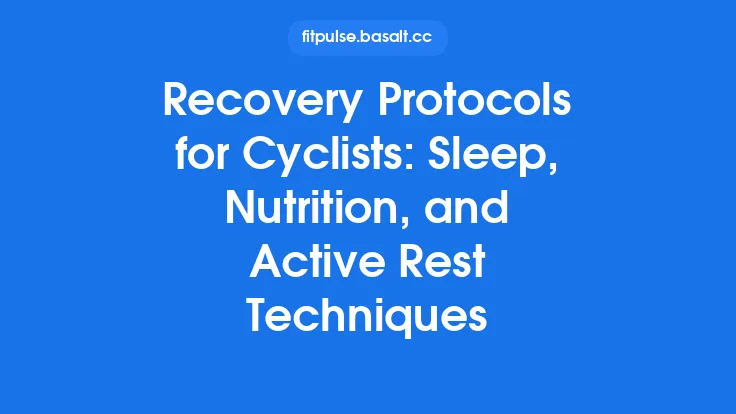Endurance athletes subject their bodies to prolonged periods of aerobic stress, depleting energy stores, stressing cellular structures, and triggering a cascade of metabolic and hormonal responses. The window after a long‑duration session is a unique opportunity to steer the body toward repair, adaptation, and preparation for the next training demand. While the immediate focus often lands on rehydration and carbohydrate refueling, a truly comprehensive post‑workout nutrition plan must address the full spectrum of macronutrients, micronutrients, and timing considerations that support long‑duration recovery. Below is an in‑depth exploration of the principles, physiological underpinnings, and practical strategies that endurance athletes can employ to optimize their post‑exercise nutrition without duplicating the more narrowly focused topics covered elsewhere in the recovery series.
Understanding the Energy Demands of Endurance Exercise
Prolonged aerobic activity primarily relies on oxidative metabolism, drawing on both glycogen stored in muscle and liver as well as circulating free fatty acids. As the duration extends beyond the 90‑minute mark, the proportion of energy derived from fat oxidation rises, yet glycogen remains a critical substrate for maintaining intensity, especially during the later stages of a race or long training session. The depletion of glycogen, combined with the oxidative stress generated by sustained mitochondrial activity, creates a physiological environment that demands:
- Replenishment of depleted energy substrates – not just glucose, but also the intramuscular triglyceride pools that have been mobilized.
- Repair of oxidative damage – reactive oxygen species (ROS) generated during prolonged exercise can impair membrane integrity and protein function.
- Restoration of hormonal balance – cortisol, catecholamines, and insulin fluctuate dramatically, influencing nutrient partitioning and tissue repair.
Understanding these demands sets the stage for a nutrition plan that goes beyond simple carbohydrate loading and addresses the broader recovery landscape.
Macronutrient Balance Beyond Carbohydrates
While carbohydrate restoration is essential for glycogen resynthesis, the other macronutrients—protein and fat—play equally vital roles in the recovery of endurance athletes.
Protein: Quality Over Quantity
Endurance training induces micro‑damage to muscle fibers, particularly the contractile proteins (actin, myosin) and structural proteins (titin, desmin). Providing high‑quality protein supplies the essential amino acids needed for:
- Muscle protein synthesis (MPS) – rebuilding damaged contractile elements.
- Synthesis of mitochondrial proteins – supporting adaptations that improve oxidative capacity.
- Production of enzymes involved in metabolic pathways – such as those required for fatty acid oxidation.
The emphasis should be on protein sources that deliver a complete amino acid profile, including all essential amino acids, rather than focusing solely on the amount consumed. This approach supports efficient repair without overemphasizing the timing nuances that are covered in other articles.
Fat: The Unsung Hero of Recovery
Dietary fat is often overlooked in post‑exercise nutrition, yet it fulfills several recovery‑critical functions:
- Replenishment of intramuscular triglycerides (IMTG) – especially important for athletes who rely heavily on fat oxidation during long sessions.
- Provision of essential fatty acids (EFAs) – omega‑3 and omega‑6 fatty acids are precursors for eicosanoids, which modulate inflammation and vascular function.
- Facilitation of fat‑soluble vitamin absorption – vitamins A, D, E, and K are integral to immune function, bone health, and antioxidant defenses.
Incorporating moderate amounts of healthy fats (e.g., nuts, seeds, avocados, fatty fish) within the post‑workout meal can accelerate the restoration of IMTG stores and support anti‑inflammatory pathways.
The Critical Role of Dietary Fats in Recovery
Endurance athletes often experience a shift toward greater reliance on fat oxidation as training progresses—a phenomenon known as “fat adaptation.” Post‑exercise nutrition that includes dietary fats can reinforce this adaptation by:
- Stimulating the activity of lipoprotein lipase (LPL) – an enzyme that facilitates the uptake of fatty acids into muscle cells.
- Supporting mitochondrial biogenesis – omega‑3 fatty acids, particularly EPA and DHA, have been shown to up‑regulate PGC‑1α, a master regulator of mitochondrial formation.
- Modulating cell membrane fluidity – essential for optimal function of ion channels and transporters involved in muscle contraction and recovery.
A balanced inclusion of monounsaturated and polyunsaturated fats, while limiting saturated fat intake, aligns with both performance goals and long‑term cardiovascular health.
Micronutrients and Antioxidants for Cellular Repair
Prolonged aerobic activity elevates oxidative stress, leading to the formation of free radicals that can damage lipids, proteins, and DNA. Micronutrients with antioxidant properties are therefore indispensable in the post‑workout window.
| Micronutrient | Primary Function in Recovery | Key Food Sources |
|---|---|---|
| Vitamin C | Scavenges ROS, supports collagen synthesis for connective tissue repair | Citrus fruits, berries, kiwi |
| Vitamin E | Protects cell membranes from lipid peroxidation | Almonds, sunflower seeds, spinach |
| Selenium | Cofactor for glutathione peroxidase, an enzyme that neutralizes peroxides | Brazil nuts, seafood, whole grains |
| Zinc | Involved in DNA synthesis, immune function, and protein repair | Oysters, pumpkin seeds, legumes |
| Magnesium | Crucial for ATP production, muscle relaxation, and glycogen synthesis | Dark leafy greens, nuts, whole grains |
| Iron (especially for female athletes) | Supports oxygen transport and mitochondrial respiration | Lean red meat, lentils, fortified cereals |
| Vitamin D | Modulates inflammation, supports bone health, and influences muscle function | Fatty fish, fortified dairy, sunlight exposure |
Ensuring adequate intake of these micronutrients—through a varied diet rich in fruits, vegetables, nuts, seeds, and lean animal products—creates an internal environment conducive to rapid cellular repair and reduced delayed‑onset muscle soreness (DOMS).
Strategic Use of Anti‑Inflammatory Nutrients
Inflammation is a natural response to the mechanical and metabolic stress of endurance training, but chronic or excessive inflammation can impede adaptation and increase injury risk. Certain nutrients possess potent anti‑inflammatory properties that can be strategically incorporated into the post‑exercise meal:
- Omega‑3 fatty acids (EPA/DHA) – down‑regulate pro‑inflammatory cytokines (e.g., IL‑6, TNF‑α) and promote the production of resolvins, which aid in the resolution phase of inflammation.
- Curcumin (from turmeric) – inhibits NF‑κB signaling, a key pathway in inflammatory gene expression.
- Gingerol (from ginger) – exhibits similar NF‑κB inhibition and reduces oxidative stress.
- Polyphenols (e.g., quercetin, catechins) – found in berries, green tea, and dark chocolate, these compounds modulate inflammatory pathways and improve endothelial function.
Incorporating these foods in moderate amounts—such as a serving of fatty fish, a turmeric‑spiced vegetable dish, or a berry‑based dessert—can help temper the inflammatory response without blunting the beneficial training adaptations that some degree of inflammation is required for.
Periodized Post‑Workout Nutrition for Training Cycles
Endurance training is rarely static; it follows a periodized plan that alternates between high‑volume, low‑intensity phases and high‑intensity, low‑volume intervals. Nutrition should mirror this structure:
- Base Phase (high volume, low intensity)
- Emphasize steady carbohydrate intake to maintain glycogen stores.
- Increase fat intake to support the heightened reliance on lipid oxidation.
- Prioritize micronutrient density to sustain immune health during prolonged training weeks.
- Build Phase (moderate volume, higher intensity)
- Slightly raise protein proportion to accommodate increased muscle repair demands.
- Maintain balanced fat to continue supporting mitochondrial adaptations.
- Introduce targeted anti‑inflammatory foods after particularly taxing interval sessions.
- Peak/Taper Phase (reduced volume, race‑specific intensity)
- Fine‑tune carbohydrate availability to ensure maximal glycogen stores for competition.
- Keep protein intake consistent to preserve lean mass during reduced training load.
- Focus on hydration and electrolyte balance (covered elsewhere) while ensuring adequate antioxidant intake to mitigate any residual oxidative stress.
By aligning macronutrient ratios and micronutrient emphasis with the specific demands of each training block, athletes can enhance adaptation, reduce fatigue, and improve overall performance.
Practical Meal Planning for Endurance Athletes
Translating these principles into everyday meals requires thoughtful planning, especially when training sessions are long and may occur at irregular times. Below is a framework that can be customized to individual preferences, dietary restrictions, and training schedules.
1. Immediate Post‑Exercise Window (0–30 minutes)
- Goal: Initiate glycogen replenishment, deliver essential amino acids, and begin the anti‑oxidative response.
- Meal composition: A balanced blend of carbohydrate (moderate), high‑quality protein, and a small amount of healthy fat.
- Example: A bowl of oatmeal mixed with whey or plant‑based protein powder, topped with a handful of berries and a drizzle of nut butter.
2. Recovery Meal (1–2 hours post‑exercise)
- Goal: Complete glycogen restoration, support muscle repair, and provide a broader spectrum of micronutrients.
- Meal composition: Larger portion of complex carbohydrates, a generous protein serving, and a moderate fat source, accompanied by a colorful array of vegetables.
- Example: Grilled salmon (or tempeh for a plant‑based option) with quinoa, roasted sweet potatoes, and a mixed‑leaf salad dressed with olive oil and lemon.
3. Evening Meal (4–6 hours post‑exercise)
- Goal: Consolidate recovery, replenish any remaining nutrient deficits, and promote overnight repair.
- Meal composition: Emphasize protein and micronutrient density, with a lighter carbohydrate load if glycogen stores are already restored.
- Example: Stir‑fried tofu (or lean chicken) with broccoli, bell peppers, and a side of brown rice, finished with a sprinkle of sesame seeds for added zinc and magnesium.
4. Snack Options (if needed)
- Goal: Bridge gaps between meals without overloading the digestive system.
- Guidelines: Choose whole‑food snacks that provide a mix of protein, healthy fat, and antioxidants.
- Examples: Greek yogurt with a dash of cinnamon, a small handful of almonds and dried apricots, or a slice of whole‑grain toast topped with avocado and cherry tomatoes.
Integrating Whole‑Food Strategies with Targeted Supplementation
While a well‑rounded diet can meet most nutritional needs, certain circumstances—such as intense training blocks, travel, or dietary restrictions—may warrant supplementation. The key is to use supplements to complement, not replace, whole‑food intake.
| Supplement | Rationale for Endurance Recovery | Recommended Use |
|---|---|---|
| Vitamin D3 | Supports bone health, immune function, and muscle recovery, especially in athletes training indoors or at high latitudes. | 1,000–2,000 IU daily, adjusted based on serum levels. |
| Magnesium glycinate | Facilitates ATP production, muscle relaxation, and reduces cramping. | 200–400 mg in the evening, preferably with dinner. |
| Omega‑3 fish oil (EPA/DHA) | Anti‑inflammatory, enhances mitochondrial function, may improve endurance performance. | 1–2 g EPA/DHA combined daily, split across meals. |
| Curcumin with piperine | Potent anti‑inflammatory and antioxidant effects; piperine enhances absorption. | 500 mg curcumin + 5 mg piperine post‑exercise. |
| Electrolyte tablets (low sodium) | For athletes who already meet sodium needs through diet but require other minerals (potassium, magnesium). | Use during prolonged sessions where sweat losses are high, but not as a primary electrolyte source. |
When selecting supplements, prioritize third‑party tested products to ensure purity and potency. Always consider individual tolerance and consult a sports nutrition professional if unsure.
Monitoring Recovery and Adjusting Nutrition
Effective nutrition is dynamic; it should evolve based on measurable recovery markers and training load. Athletes can employ several practical tools:
- Subjective wellness questionnaires – rate perceived fatigue, muscle soreness, and sleep quality each morning.
- Performance metrics – track changes in heart‑rate variability (HRV), pace, and power output across sessions.
- Body composition analysis – monitor lean mass and fat mass to ensure that energy intake aligns with training demands.
- Blood biomarkers (optional) – periodic checks of ferritin, vitamin D, and inflammatory markers (e.g., C‑reactive protein) can reveal hidden deficiencies.
If an athlete reports persistent fatigue, elevated soreness, or declining performance, the nutrition plan should be revisited. Common adjustments include increasing overall caloric intake, boosting protein density, adding more antioxidant‑rich foods, or fine‑tuning the timing of meals relative to training.
Common Pitfalls and Evidence‑Based Solutions
| Pitfall | Why It Happens | Evidence‑Based Fix |
|---|---|---|
| Relying solely on “quick carbs” post‑exercise | Habitual focus on glycogen without considering protein and fat needs. | Pair carbohydrate sources with high‑quality protein and a modest amount of fat to support MPS and hormonal balance. |
| Neglecting dietary fat after long sessions | Misconception that fat slows digestion and impedes recovery. | Research shows that moderate fat intake does not impair glycogen resynthesis and aids in IMTG restoration and anti‑inflammatory pathways. |
| Over‑emphasizing antioxidant supplements | Belief that mega‑doses of vitamins will eliminate oxidative stress. | High doses can blunt training adaptations; whole‑food antioxidants provide a balanced, bioavailable approach. |
| Skipping the post‑exercise meal due to time constraints | Busy schedules or training late in the day. | Prepare portable, nutrient‑dense meals (e.g., protein‑rich wraps with avocado) that can be consumed within the first hour after training. |
| Ignoring micronutrient adequacy | Focus on macronutrients alone. | Regularly include a variety of colored fruits, vegetables, nuts, and seeds to cover the spectrum of vitamins and minerals essential for recovery. |
By recognizing these common missteps and applying research‑backed corrections, endurance athletes can fine‑tune their post‑workout nutrition to support sustained performance and long‑term health.
In summary, post‑workout nutrition for endurance athletes is a multifaceted discipline that extends far beyond simple carbohydrate refueling. A balanced approach that integrates high‑quality protein, strategic dietary fats, a rich array of micronutrients, and anti‑inflammatory foods—tailored to the specific phase of the training cycle—creates the optimal internal environment for glycogen restoration, cellular repair, and adaptation. Coupled with vigilant monitoring and thoughtful supplementation when needed, these practices empower endurance athletes to recover efficiently, reduce injury risk, and consistently perform at their best across long‑duration events.





